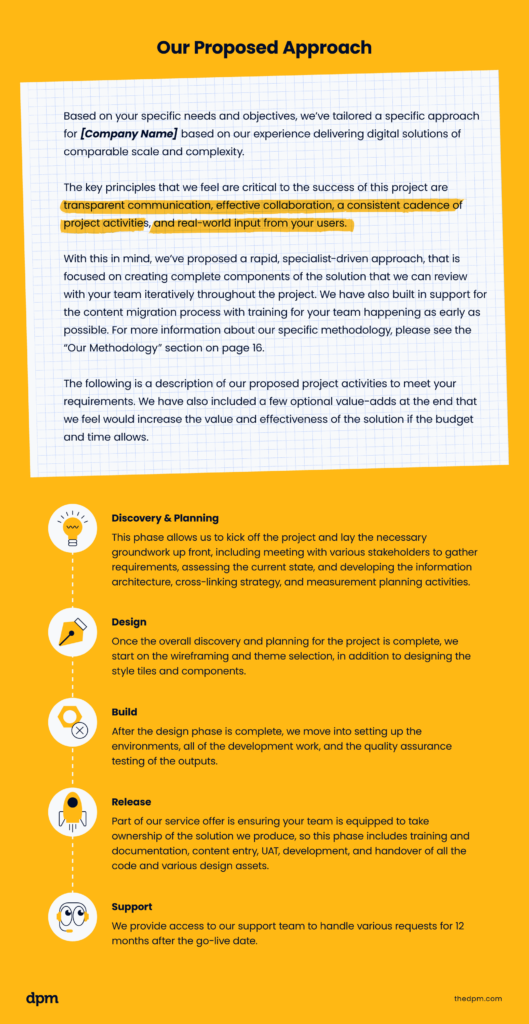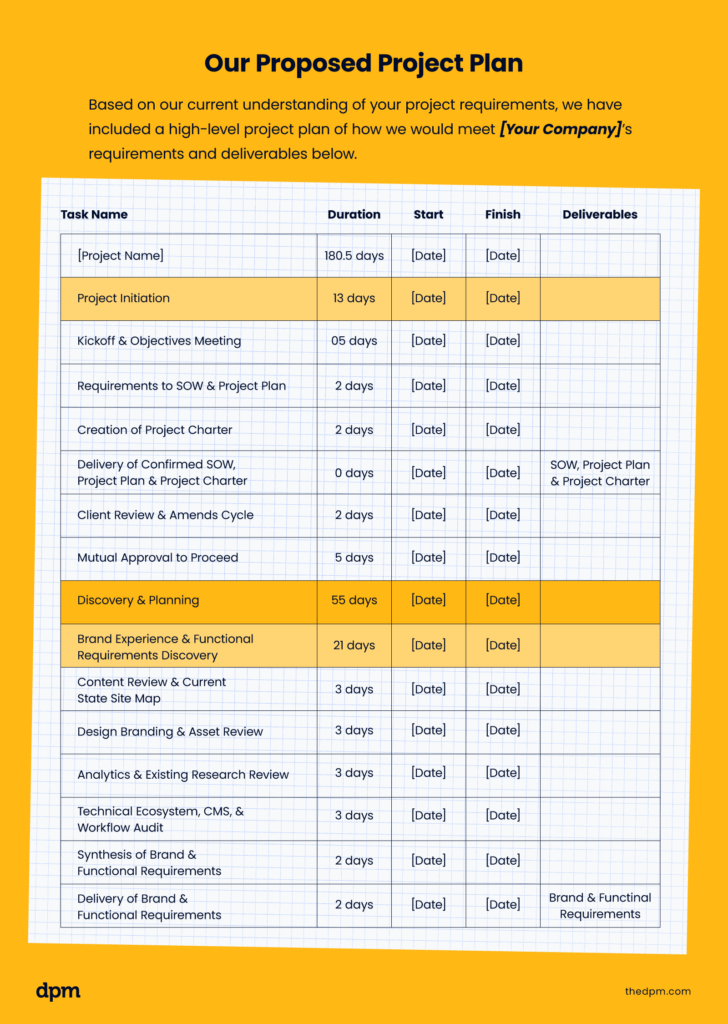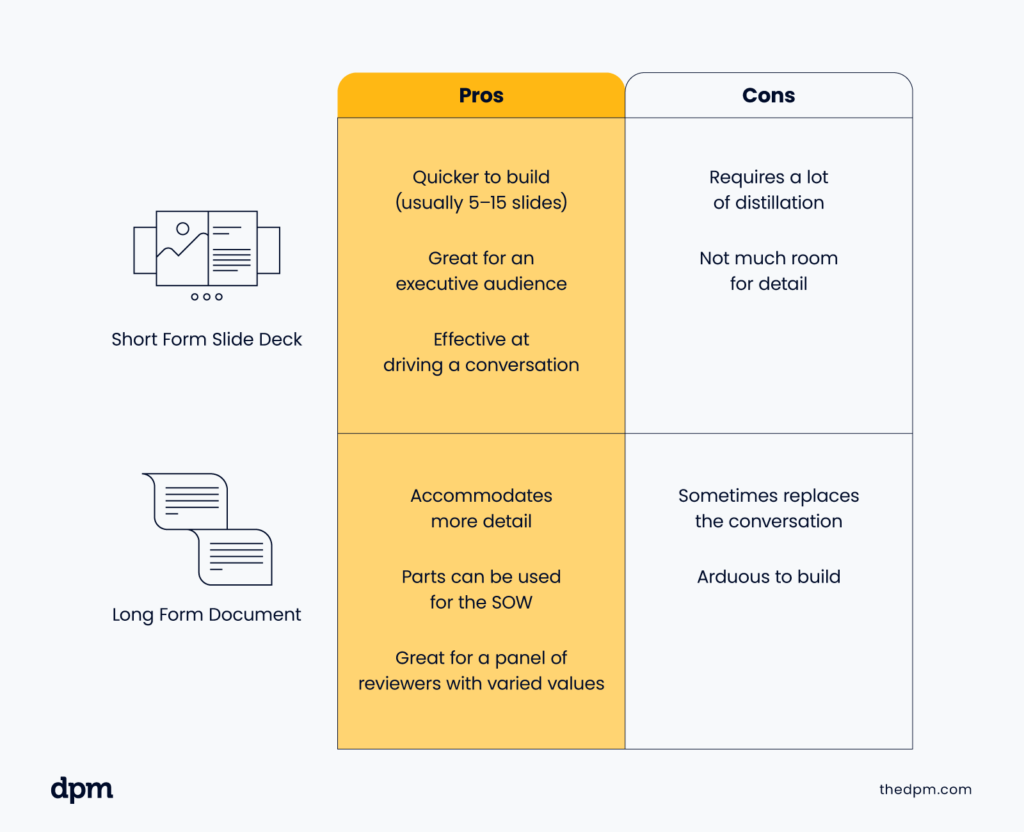As a project manager, business development is most likely not one of your areas of responsibility. But, having the opportunity to either review or help craft a project proposal before it goes to a client or customer can help ensure a smoother project delivery.
After spending about a decade working in sales and writing countless winning proposals, I’m excited to share some ideas and best practices to help you and your teams leverage your proposals to win more business and better projects.
What Is A Project Proposal?
When it comes to making a formal bid for new work, a project proposal generally refers to a written document that will be submitted to an internal sponsor, a client, or a prospective client that builds a case to have your team deliver a scope of work.
The proposal should tell the reader who will do what, by when, and even why and how.
What Is The Purpose Of A Project Proposal?
The purpose of a project proposal is to help someone understand why your team should be the ones to do the work. This is why it’s very important that a proposal is well crafted and tells a compelling story.
In addition to helping your external audience understand, creating the proposal is an opportunity for the internal team to align on the scope of work and plan to accomplish it.
More about why project proposals are important here.
Who Creates Project Proposals?
The person or team responsible for writing project proposals will depend highly on the organization and the audience for the proposal. If you work in-house, as opposed to an agency, you (or the person leading the project) might be responsible for creating the proposal and sharing it with your manager or the project’s approver.
In an agency setting, often, the project proposal process is owned by business development or the agency’s leadership team.
The project manager and key project team members may be consulted to determine the feasibility and weigh in on things like estimated hours or constraints that must be addressed in the proposal to ensure the project’s overall success.
Project Proposal vs Project Charter vs Project Plan
In the typical project life cycle, the project proposal, project charter, and project plan may be developed sequentially but could also overlap. The project proposal may need to include the proposed project charter and project plan, but these documents may be refined before the project officially kicks off.
Once all parties have agreed to the project charter, the project plan can be confirmed (or developed if it hasn’t yet). The project charter is the project’s north star and how project success will be measured. At the end of the project, the team will ensure that what was outlined in the charter has been accomplished.
The project plan will break down the work needed to execute against the charter and document who will do the work and when it will be completed. The project plan will help keep the team aligned with the overall project schedule and can also help ensure the project budget is utilized correctly across the project.
Two Types Of Project Proposals
Solicited Project Proposals (RFP)
In some cases, a project proposal is solicited by an organization seeking a vendor or partner to complete a specific body of work.
In this case, the organization may send you or your team a formal document called a request for proposal (RFP). Depending on your relationship with the requesting organization, this may not need to be as formal and maybe an email or even an inquiry through your website.
When responding to an RFP it is important to understand that the organization that sent the request may have sent the same request to several (or many) other organizations.
In some types of projects, like government or municipal projects, the RFP may be required to be posted publicly for a period of time. This is to allow any interested parties to respond to the request.
Your potential client may have outlined specific formats and deliverables they need to accept your proposal. Follow any instructions carefully as this is not the time to go rogue.
Missing a key document or using a different format could disqualify you and your team from moving forward in the proposal process.
Unsolicited Project Proposals
The other type of project proposal you or your team may create is what is called an unsolicited project proposal. This is when you are proactively creating a proposal based on a perceived (or informally expressed) need.
While unsolicited proposals are more likely ignored or rejected, there are some advantages to creating an unsolicited proposal. First, you may face less competition than in a formal RFP process. This is simply because you approached the prospect first.
The other advantage of an unsolicited proposal is the ability to craft a solution with your potential new client.
Since there isn’t a formal RFP, and you aren’t being judged on a specific set of project requirements or project deliverables, you’re better able to craft a solution that achieves the project objectives and speaks directly to the client’s needs and project budget.
This is sometimes called “getting in before the RFP,” and it can be an advantage to your team or agency.
How do you do this? Through a combination of networking and research. For example, if you’re at an industry event or conference and you’re speaking to potential clients, you hear someone in a group casually mention that they’re considering re-designing their website.
Reaching out with a proposal (or starting to gather information to write one) before the team has sent out a formal RFP can put you at an advantage.
Another way to do this is to review websites or digital projects your team might want to work on. Say you’d love to redesign a certain company’s digital marketing strategy. Look at what they’re currently doing and identify some opportunities for improvement.
Instead of waiting to see if they’re shopping for a strategy team, send out your proposal with ideas and inspiration as to what it could look like if this company moved forward with your team.
What Should A Project Proposal Include?
There isn’t a one-size-fits-all, silver bullet format or definitive list of ingredients for an effective project proposal, but here’s a list of the most common sections needed to make sure you cover all of your bases:
Example Project Proposal Outline
Executive Summary
Provide a brief (max 1-2 paragraph) introduction that summarizes the challenge, the solution, and the approach you’d take for project stakeholders.
This section should be tailored to a senior leader who may be responsible for approving the overall project but doesn’t need all the nitty-gritty details of how the work will get done or who will be involved. So keep it high level and include the most important information succinctly.
Our Understanding
Reframe the challenge and project background in a way that shows you understand the realities, constraints, and inherent value of solving that challenge.
If your team has had preliminary conversations with the potential client or team, use some of the language you heard in these conversations to show you were listening and understand what they’re seeking.
Our Solution & Proposed Approach
This will be one of the largest sections of the proposal and will have a lot of the “meat.” It should include the following:
- Description of your proposed solution and approach
- The methodology you’ll use to manage the project
- The way you’ll communicate with stakeholders
- The project scope and deliverables you will produce,
- Metrics you’ll use to measure the success of the project
- The overall value completing the project will bring to the organization
Project Plan & Key Milestones
Show that you have a realistic project plan and timeframe to get the job done in the context of your buyer’s business.
Before presenting this timeline to your potential client or partner, ensure that some of your team who will be responsible for completing the work feel that the timeline is achievable and the milestones are correctly identified. Resource management is only as good as the timeline and project plan are realistic and achievable.
Project Costs
Provide the cost to deliver the desired results. Your pricing should include service fees, ancillary fees, contingency, and tax (if applicable). Where possible, describe this in the context of value: what will your buyer get regarding outcomes and impact? If you know your potential client’s target budget, address how you’ve considered that.
If the number feels unrealistic, address that in your proposal. I recommend that you provide two sets of project costs. One that shows what you can do within their target budget and the second that shows the realistic costs of everything they’ve asked for.
With the latter, ensure you’re providing the value proposition to explain why spending additional funds on this work now will be beneficial in the long run.
Proposed Team Members
If you work for a smaller agency or you feel confident that you know how you’ll staff the proposed project, add this section to your proposal. It will help you to prove that you have qualified people to do the work and help your potential client get excited about working with a specific project team.
You want to articulate what each member will contribute to the project's success and any special skills or knowledge each person will bring to the table.
Case Studies or Awards
This is where you can brag a little! Prove that you have the skills and experience to deliver successful projects of this nature. Where possible, show that you’ve done it before at a comparable scale.
While the focus of your proposal should be on what you will do to benefit the specific client, having some testimonials, case studies or awards to show your experience can help you win the business.
If you have some previous satisfied clients who are happy to act as a reference for your team, consider sharing it in the proposal (with permission) so that your potential client can learn more about what it’s like working with you.
Assumptions & Needs
Articulate the assumptions you’ve made as the basis of your estimate, and be clear about what you would need from your buyer throughout the project in order to meet the objectives that have been agreed to. For example, things like:
- This proposal assumes the client will provide the copy for the landing page and new pages of the website by X date.
- The pricing in this proposal covers three rounds of design feedback and revisions.
- All stakeholders will attend design review meetings and provide feedback within five business days.
- The project team will have editing access to the back end of the website and relevant plugins.
- The project timeline is contingent on the SOW being signed by X date.
Supplemental Information
Provide any additional information or additional resources you want or need to share. This could include a corporate / team overview, technical information, detailed descriptions of solution functionality, proposed approval workflows, the project management software and communication tools you’ll use, any forms, service agreements, or draft contract language.
In terms of sequencing, the order you present this information (and if you include it at all) will depend entirely on your audience and what they care about.
Read that again: this is about what your audience cares about, not how you want to structure it. Think of it as telling a story that evokes emotion and conviction, even if it isn’t read cover-to-cover.
What Does A Project Proposal Look Like?
There are many different types of proposal formats, but rather than try to cover them all, we will look at two ends of the spectrum—short-form slide decks and long-form documents.

The Short-Form Slide Deck
When you have a chance to get in front of a senior audience but only have a short amount of time to convince them your approach is the right one, a succinct and punchy deck that provokes dialogue is your best bet. Think of this similar to your elevator pitch.
While you’ll likely have longer than 2-3 minutes, you want to make sure you’re not burying the lede, and you’re making the most important and compelling points without any fluff!
This is typically a 5-15 slide deck that zeroes in on exactly what your audience cares about. That means you need to truly take the time to step into your buyer’s mindset:
- Do they feel they need a team that deeply understands their business challenges and politics to be effective?
- Are they looking for a bulletproof approach tailored to their needs instead of a canned methodology?
- Are they looking for proof that you can deliver tangible results while avoiding the risks that keep them up at night?
This format deliberately stays out of the weeds, usually prioritizing business impact over minutiae about your methodology and day-to-day project work. It also strives to answer the key questions while leaving some mystery to drive a deeper conversation.
When you rehearse your presentation, it should take less than half the time you have allocated for the meeting to allow for some discussion in real time during the presentation. And while this type of project proposal can be shared outside the meeting and stand on its own, what it is meant to be is the talking points for executives when they are rallying buy-in from their teams.
Pros:
- Quicker to build
- Great for an executive audience
- Effective at driving a conversation
Cons:
- Requires a lot of distillation
- Not much room for detail

The Long-Form Document
When you are asked to paint a detailed picture of your approach to a panel of cross-functional decision-makers who care about very different things, a longer document is probably in order.
This can be almost any length (I’ve done 30-pagers and 220-pagers and everything in between), but the key is that the document is well organized into chapters that will mean something to your readers. This is your chance to convince their enterprise architect that your proven approach to legacy systems integration will scale with their needs for years to come.
This is your chance to re-iterate the value of your human-centered design philosophies to their director of customer experience. This is your chance to showcase how you plan to collaborate with their business intelligence team to build an analytics engine that leverages next-generation machine learning and AI.
This format uses its content to speak directly to specific decision-makers while reinforcing key win themes throughout. It tells a good story when read in full, but also anticipates that it might be read out of sequence or that some of its readers may only read the sections that they care about.
It attempts to answer a wide range of questions by bringing the project to life for its readers. In some cases, it contains enough detail that parts of it can be used to inform the SoW.
Pros:
- Accommodates more detail
- Parts can be used for the SOW
- Great for a panel of reviewers with varied values and priorities
Cons:
- Runs the risk of replacing the conversation
- Requires an intensive proposal writing process

Project Proposal Template & Example
For members of the DPM community, we offer a number of project proposal templates and examples that you can leverage or that can inspire you to create winning proposals of your own.
Having a template, as well as looking at examples of other proposals, can help you to see what works and what doesn’t. As you look at examples of other proposals, put yourself in the shoes of a prospective customer. What will they think? What things will resonate with them?
Looking at other proposals, even outside of your industry, can provide loads of inspiration. Look at what you like and see if you notice any trends that you might be able to leverage when writing your own proposals.
How To Create A Project Proposal
Creating project proposals doesn’t have to be overwhelming; using a template like the one we just reviewed, you might want to proactively start by creating your own template (or templates if you offer multiple services) so they’re ready for customization.
When you’re ready to create a proposal for a new client, here is an easy step-by-step process to make it easier for you and your team to collaborate and wow them!
- Determine what services you will be proposing
- Choose the right project template from your template library
- Sketch out the offer, project team, and any important information for this specific project
- Add all relevant details to your proposal, ensuring it is 100% customized. You may have to remove some information that isn’t relevant to this opportunity.
- Have members of the project team or colleagues review the proposal. Is anything unreasonable or unclear? Do the timing and pricing feel right for the scope of work?
- Address any feedback you received in the previous step.
- Reroute the proposal for final review and approval.
- Send your proposal off to your prospective client (or deliver it in a presentation)
- Cross your fingers and wait for the good news that your proposal has been accepted!
Creating proposal templates is now easier than ever. There are many types of proposal software out there that create beautiful and interactive sales and project proposals. These include Qwilr, PandaDoc, Proposify, and even Canva and Google Slides can be used for this purpose.
Whatever tool you choose for creating and distributing your proposals, it’s important to keep your template library updated so that proposals can be created quickly, accurately, and efficiently.
Outdated templates can lead to additional work or sending clients old services, or worse, old rates, which means you’re leaving money on the table.
Get more details on the process of creating a project proposal here.
Next Steps
Now that you’re armed with examples, templates, and a clear process to create good project proposals, there is one more skill you may want to brush up on to take your proposals to the next level.
That would be the ability to estimate project work. Having a client accept a proposal for work that wasn’t estimated correctly could cost your team or agency big.
This is why being able to accurately estimate and provide a reasonable and realistic amount of hours and budget for the project is key! If you need tips and strategies for more accurate estimates at every phase of the project life cycle, check out our guide to creating estimates.
Like what we have to offer? Get the Digital Project Manager’s latest articles, guides, and stories delivered right to your inbox! Subscribe to The Digital Project Manager newsletter!

